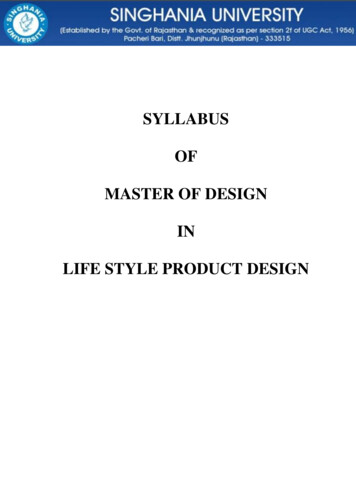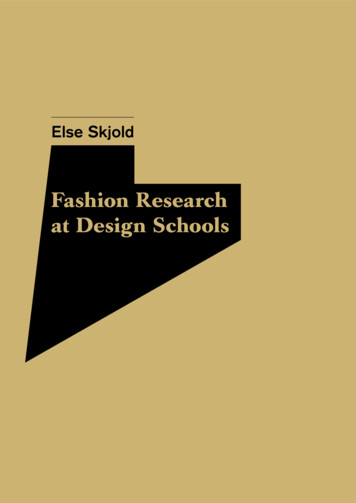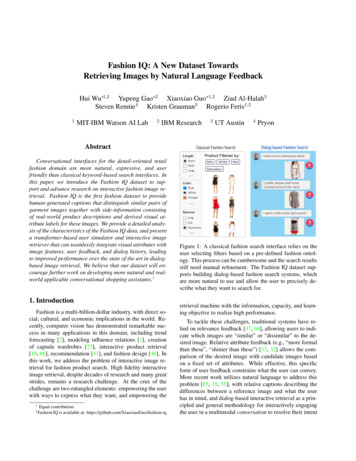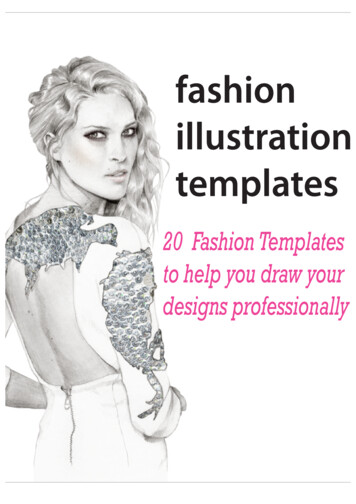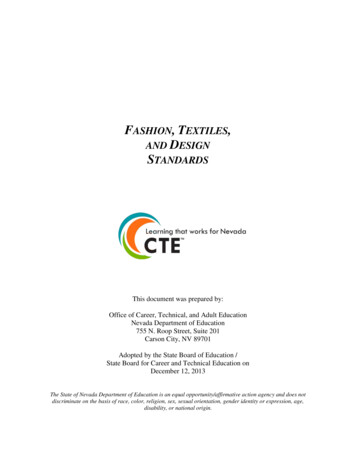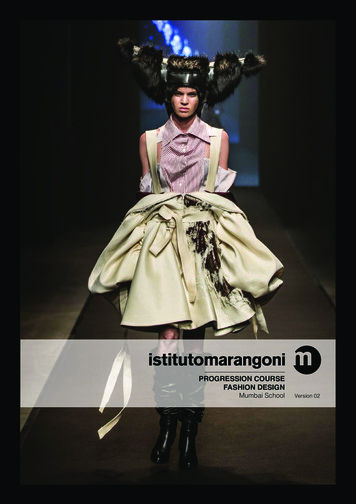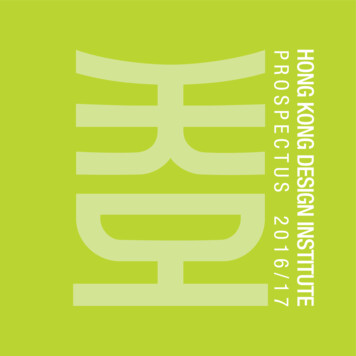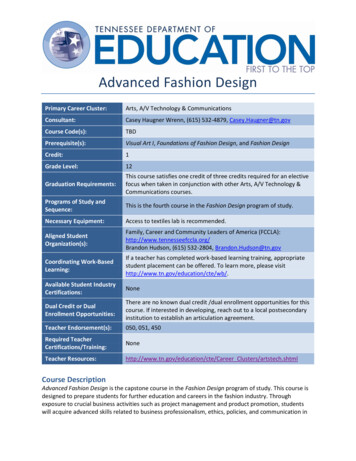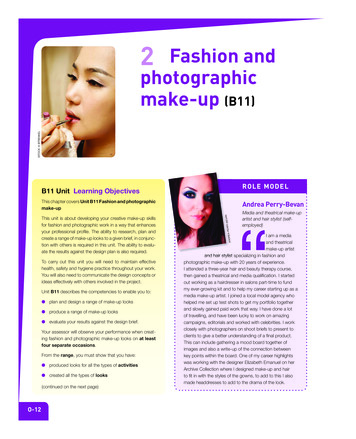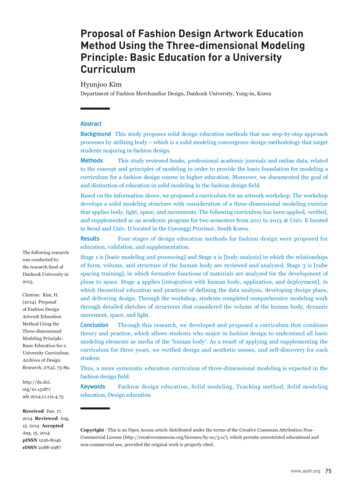
Transcription
Proposal of Fashion Design Artwork EducationMethod Using the Three-dimensional ModelingPrinciple: Basic Education for a UniversityCurriculumHyunjoo KimDepartment of Fashion Merchandise Design, Dankook University, Yong-in, KoreaAbstractBackground This study proposes solid design education methods that use step-by-step approachprocesses by utilizing body – which is a solid modeling convergence design methodology that targetstudents majoring in fashion design.This study reviewed books, professional academic journals and online data, relatedto the concept and principles of modeling in order to provide the basic foundation for modeling acurriculum for a fashion design course in higher education. Moreover, we documented the goal ofand distinction of education in solid modeling in the fashion design field.MethodsBased on the information above, we proposed a curriculum for an artwork workshop. The workshopdevelops a solid modeling structure with consideration of a three-dimensional modeling exercisethat applies body, light, space, and movements. The following curriculum has been applied, verified,and supplemented as an academic program for two semesters from 2011 to 2013 at Univ. E locatedin Seoul and Univ. D located in the Gyeonggi Province, South Korea. Four stages of design education methods for fashion design were proposed foreducation, validation, and supplementation.ResultsThe following researchwas conducted bythe research fund ofDankook University in2013.Citation: Kim, H.(2014). Proposalof Fashion DesignArtwork EducationMethod Using theThree-dimensionalModeling Principle:Basic Education for aUniversity Curriculum.Archives of DesignResearch, 27 (4), .75Stage 1 is [basic modeling and processing] and Stage 2 is [body analysis] in which the relationshipsof form, volume, and structure of the human body are reviewed and analyzed. Stage 3 is [cubespacing training], in which formative functions of materials are analyzed for the development ofplane to space. Stage 4 applies [integration with human body, application, and deployment], inwhich theoretical education and practices of defining the data analysis, developing design plans,and delivering design. Through the workshop, students completed comprehensive modeling workthrough detailed sketches of structures that considered the volume of the human body, dynamicmovement, space, and light.Through this research, we developed and proposed a curriculum that combinestheory and practice, which allows students who major in fashion design to understand all basicmodeling elements as media of the ‘human body’. As a result of applying and supplementing thecurriculum for three years, we verified design and aesthetic senses, and self-discovery for eachstudent.ConclusionThus, a more systematic education curriculum of three-dimensional modeling is expected in thefashion design field.Fashion design education, Solid modeling, Teaching method, Solid modelingeducation, Design educationKeywordsReceived Jun. 17.2014 Reviewed Aug.15. 2014 AcceptedAug. 15. 2014pISSN 1226-8046eISSN 2288-2987Copyright : This is an Open Access article distributed under the terms of the Creative Commons Attribution Non-Commercial License (http://creativecommons.org/licenses/by-nc/3.0/), which permits unrestricted educational andnon-commercial use, provided the original work is properly cited.www.aodr.org75
1. Introduction1. 1. Research Background and ObjectivesIn the early 20th century, as human body was liberated from corsets and movements, clothesthat concretely expressed the beauty of the human body emerged. In other words, comingin to the 20th century, fashion emerged to become an art genre that contains the aestheticsof the times. In such movements, researches on new cutting technologies and materialsbecame more and more active, and new forms of clothes appeared in the fashion design field.Such movements were even more accelerated being inter-locked with art, and the conceptof structure of western fashion was overturned by the emergence of an abstractive formthat violated the orthodox modeling of ‘body’. For example, like the Japanese kimono thatcontains extra spaces between clothes, or the introduction of "human body modeling" tocreate newly-structured clothes.Thus, in order to respond to the flow of fashion design, design education researches that arebased on step-by-step application of three-dimensional principles are needed to contributein the improvement of creativity. However, researches and preceding data regarding designeducation and specific curriculums are insufficient. In Korea, "The Study on the Developmentof Contents in Fundamental Design Education For Fashion Design" by Cho, J.(2010) is thesole research regarding fashion design education based on modeling principles. In foreigncountries, most researches regarding design education are focused on integrated design orearly design educations for children. Like Korea, not much researches on design educationare focused on fashion design.In contrary to the fashion field, researches and studies of design education based on three-dimensional principles are actively being progressed in other design fields. In "The Studyon the Method of Design Education to Improve Cubic Art Creativeness", Park H.(2003)proposed the principles of 3D design education and methodology for improving 3D designcreativity. In "A Proposal for Fundamental Design Curriculum at Universities in Korea", Ha,S.(2009) pinpointed the importance of fundamental design education as well as proposingthe 3-step curriculum called "IME & H". In "A Study on the Recognition and Importance ofAbstract 3-Dimensional Form in Design Education", Lee, Y.(2011) studied the importance ofunderstanding the aesthetics of 3-dimensional forms as a designer.In addition to such studies, preceding researches regarding fundamental design educationinclude studies from Yin, M.(2012) and Cha, Y.(2012). Like this, researches that propose aspecific direction and case for design education and application are insufficient.On the other hand, solid modeling educations taken place in fashion design schools belongingto higher education institutes in Korea are poor in comparison to major intensive courseeducations. Most cases of design educations in the fashion design major are focused onsimply teaching basic modeling methods of other design fields such as textile rather thancreating actual forms and models.However, due to the nature of the fashion design field which should consider 3-dimensionsincluding human body and clothes, the correlation between them and even other dynamicmovements, the absence of an appropriate solid modeling education in fashion designeducation may lead to lack of creation, application and thinking ability, and cause decretionof adaptability in the rapidly- changing fashion market.76 Archives of design research 2014. 11. vol 27. no4
Thus, in order to foster fashion designers to lead the future, re-establishing of solid modelingeducations and strengthening of training is necessary in higher education institutes.Additionally, supplementation of design education and teaching method considering theassociation with university major subjects is also required.Accordingly, the objective of this research lies on proposing a solid modeling educationalmodel to improve creative abilities of fashion designers who recognize fashion design asmodeling art that realizes on human body beyond a fragmentary approach that simply showsdesign uniqueness.1. 2. Research Method and ScopeIn this research, the following research methods have been applied to develop a solidmodeling education curriculum for fashion design in a higher education.To start with, a logical understanding stage was preceded on modeling and modelingprinciple through books, professional journals and related online data and DB. In order tostudy and understand the basic principles of 3-dimensional forms applied in 2-dimensionalforms such as paper, professional books such as 'Modeling Practice-3D form experimentthrough paper' by Franz, Z.(2008), 'Design Basics' by David L.(2006), 'Understanding of solidmodeling' by Kim, M. and Baek, S.(2003), 'Solid Modeling' by Han, S.(2006), 'Paper craft-Design and art with paper' by Robert, K.(2009), and 'Advanced Origami' by Michael, G. &LaFosse(2005) were reviewed. In addition, preceding researches regarding design educationof various design fields were reviewed along with online database from writers such asRobert Lang, John Montroll, Akira Yoshizawa, Ilan Garbi, and Eric Gjerde.Through the literature review based on preceding researches, fashion artwork designeducation methods based on 3-dimensional principles were proposed. Thus, in order toimplant 3-dimensional thoughts that include human body and modeling to the students andfuture fashion designers, human body-based solid models were continuously manufacturedand practiced, and photographs of the outcome models were taken in a studio along with theindividual concepts in consideration of the human body, light, and space.The following curriculum proposed in the research have been applied, verified, andsupplemented as an academic curriculum from years 2011 to 2013 in Univ. E located in Seouland Univ. D located in Gyeonggi province for two semesters each for a total of three years.2. Solid Modeling Education in University Design Education2. 1. Concept and Objectives of Solid Modeling EducationSolid modeling education can be expressed through a variety of techniques as a medium ofimage setting and material expression. It is a working area that controls and coordinates theworking elements through physical force, which requires the exact purpose and convergenceof various factors. Solid modeling education can be understood as an element of form, color,texture, and space, which can contribute in the improvement of aesthetic tastes. Also, itallows to express emotional gratification or pleasure, harmony and tension at the formativestage, which aims in delivering the exact message. In this context, Naomi, A. (2000) stressedthe importance of the education of solid modeling as a professional field to be researchedwww.aodr.org77
and educated on common basic important problems in terms of 3D modeling activitiesthroughout a vast range.The parts which solid modeling education shows difference from modeling education areas follows: In the basic modeling elements, there are point, line, plane, form, color andtexture, and we get to concentrate on studies on various problems arising when theseelements combine with 3 dimensional forms. Identically for ‘Space’, a completely differentproblem arises in a 3 dimensional space and a 2 dimensional space. In addition, unlike a 2dimensional modeling, there is a model established by the fact, ‘move’, in a 3 dimensionalmodel. Types of such dynamic modeling have increased and diversified recently. Studyingand experiencing the relationship between various situations and forms are very importantin solid modeling education, as the illusions in such a fact and form should also be taken intoan account.Ultimately, the main purpose in terms of solid modeling education is expressing themodeling thinking and possibilities of materials and self discovery through the developmentof modeling sense.2. 2. Solid Modeling Education in Fashion Design FieldHuman beings have 3 dimensional forms, wear 3 dimensional forms, and live in 3dimensional forms. In particular, in the modern society, fashion design has been expressedas a model morphologic perspective while regarding researches have been constantlyconducted.Fashion completed through patterns and cuttings of fabric lose planarity as it gets worn ontothe human body, and is varied into another form met with another human body.The fabric that begins from a plane is varied into a 3 dimensional form as it gets stretched bygravity or meets with the human body.As the fashion design field should consider not only the human body and clothes but also 3dimensions including space and other dynamic motions, the stage of understanding eachmedium and ‘harmonizing’ each modeling element is essentially accompanied.According to Lee, Y. (2011), although the empirical side of understanding modeling educationas a process of self discovery through actual experiences is necessary, this does not simplyimply ‘practice’ in a narrow sense, but it is understanding the modeling elements that aredifficult to understand and acquire just by theory with ‘human body’ as a medium. Thus, theperspective of treating the process more important than result, and valuing the experiencesacquired during the process should be accompanied.After all, solid modeling education in the fashion design field is able to show vitality whenstudents develop modeling sense through theories and practices that enable to understandall basic modeling elements as ‘human body’ as the medium. The process of transformingfrom plane to solid in particular, and recognizing the domain of solid modeling includinghuman body and clothes, space, and movements through the experiences acquired from theregarding processes and fostering the ability of application and creativity can be said as theimportant key.78 Archives of design research 2014. 11. vol 27. no4
3. Fashion Design Artwork Design Education Method Utilizing Solid ModelingPrinciple3. 1. Learning ObjectiveThe objective of this class lies on proposing teaching methods for fashion artwork design thatare able to foster creativity to express one’s idea and boost one’s individuality through themedium of human body to future fashion designers, based on modeling principles of design.A designer requires not only expressing his idea by hands but also the ability to strategicallythink and express about an idea and information.Thus, in terms of making various forms of communication regardless the medium, not onlythe aesthetic side but also the planning side and the technical side should be learned aswell. In order to cultivate such ability, this class is to train for robust fundamentals on solidmodeling by carrying out solid modeling practices with human body as the medium thatcombines design planning and the technology at the solid converting stage.Especially, this course being a solid modeling course for future fashion designers and acourse linked to the future fashion design basic courses, is to teach 2 3 dimension modelingability and expression ability through modeling experiment where a new solid structure isborn by the encounter of ‘human boy’ and ‘another solid structure’. The ultimate goal lies onacquiring and cultivating pure modeling ability and creativity, and solid modeling abilitiesessential for fashion design and improving application and creation abilities.3. 2. Proceeding the Curriculum3. 2. 1. Time consumed: 3 hours 15 weeks3. 2. 2. Target grade: Freshmen3. 2. 3. Method: Theory 20% Practice 80% 3.2.4. Textbook: Main text 50%, auxiliarytest, references 30%, other online DB and data utilization 20%Table 1 ReferencesTextBook NameMainAuthorPublisherPublished yr.Modeling Practice - 3D form FRANZ ZEIER,experiment through paperTranslated byYounggil KwonNaeha2008Aux.Paper craft-Design and art withpaperRobert Klantengestalten2009Ref.Design BasicsDavid A.LauerYegyung2006Understanding of solidmodelingCo-authorship - Meeok Kim, GruSookja Beak2003Solid modelingSeokwoo HanMijinsa2006Advanced OrigamiMichael G. LaFosseTuttlePublishing20053. 3. Learning contentFour-staged education has been performed in this curriculum as follows.First, stage 1 as the data collection stage(Discover), I looked at the basic elements andprinciples of modeling in order to figure out the basic design theories related to basicmodeling and solid modeling. Furthermore, I carried out a basic processing workshop withwww.aodr.org79
paper as the basic medium, in order to cultivate sense training with the materials.Next, for stage 2 [Human body analysis], for recognition of form and volume of a humanbody, I carried out a workshop by recognizing even to the invisible opposite side and drawingwhile wrapping the human body into a contour. I lead to recognize the relationship of form,force, and structure.In stage 3, [Cube spacing training], I conducted as workshop to achieve stylization to acreative form by understanding the concept and stage which a plane becomes a solid, a space,and look for some possibilities to be applied to other solid modeling form and structure.In this stage, origami techniques were applied to challenge students in understanding therelationship of 2-dimensional planes and 3-dimensional forms by converting planes to forms.Origami technique refers to the creation of various forms by folding of a piece of paper. Thisorigami technique has been recently applied in various fashion design education for teachingstructural approaches to design. One of Korea's first curators and critic Kim, H.(2012) statedin a column about the importance of the concept of space in fashion design, stating thatfabric acts as the material of the apparel as well as creates form in the overall structure ofthe apparel. Japanese designer Issey Miyake applied the concept of space in fashion throughthe origami technique by creating dimensions beyond space and time from 2-dimensionalplanes.In this context, the following research focuses on the application of origami technique in solidmodeling design education through workshops that allow students to learn and understandthe concept of space and dimensions.In stage 4, [Integration with human body, application and deployment], I have combinedtheory and practice to deploy by dividing into data analysis stage(Define), design directiondesign(Develop) and design stage(Deliver). Firstly, in the data analysis stage, I analyzedthe modeling elements of designer works featuring modeling ideas. In the design directionstage(Develop) which was a practice stage, I deployed the concept by sketching a solidmodeling using human body. In the design and manufacture stage(Deliver), I completedthe final model work piece through detailed sketches and structures in consideration withvolume and dynamic movements of the human body, space, and light. Finally, I proposedthese in a photograph format taken in a studio as the final output.Table 2 CurriculumMain TopicNo.Sub TopicContentWhat is modelling?Basic elements and principles of modelingWorkshop 2Basic processingBasic hand processing method(Materials and sense trainingBody analysisWorkshop 3Understanding on curve Wrap and draw human body (wrapping)s u r f a c e a n d d y n a m i c Perceiving a motion with linesmovements of humanbodyCubic spacearrangementtrainingWorkshop 4From plane to spaceIntegrationwith humanboyd,applicationanddeploymentWorkshop 5Solid modeling and human Designers' work analysisbody, a new space concept development Deduce final outputBasic modelling and Workshop 1processing80 Archives of design research 2014. 11. vol 27. no4 G radation and retreat using continuousplane Solid expression using origami
3. 3. 1. Main Topic 1: Basic modeling and processing2 kinds of methods can be thought of to research the compositions in a 3 dimensional space.First, it is thinking about the composition as ‘element of shape’ classified in a basic modelingprinciple dimension like point, line, plane and solid. The other one is the exploration ofform creation by so-called material of ‘what kind of a form’ can be made by utilizing certainproperties of a certain material while focusing on the ‘material’ needed when making a piece.① Sub Topic 1: What is Modeling?(Class based on the theory and basic properties of modeling)Modeling has the meaning of making a specific form or an image by using variousdifferent materials. In order to effectively express models, the modeling elements shouldbe understood, and modeling ability should be gained by understanding the elements. Themodeling principle is a principle of how to express the modeling elements and how to handlethem. As the modeling elements for visual elements, there are shapes such as point, line andplane, and forms such as size, color and texture. For modeling elements there are unification,change, balance, rhythm and motion, and a theoretical lesson was carried out based on thesedifferent examples.② Sub Topic 2: Paper modeling (Understanding the properties of paper)[Problem posing] A solid composition is making into stylization of creative format seekingpossibilities in the physical and chemical sides of processing along with the aesthetic pursueof color and form by exploring the modeling function of the material with the method ofdestroying common sense through researches on properties, forms, functions and structureusing various materials.[Test Workshop] Paper is a material with infinite conformal modeling potential, and itsproperties differ completely depending on how dealt and processed. Thus, with paperselected as the basic material, workshop was carried out along with brainstorming andpractices.Through the workshop, I asked the students about the actions that can change the basicproperties of paper, whether it is a coincidental form and an intentional form, or whatever itis, based on the surface texture of paper. The students independently talked about processingactions that came up in their minds, and I wrote the words on the board. Then, I summarizedthe words grouped based on the modeling elements expressible in the regarding processingactions, and conducted a workshop on basic paper processing.Table 3 Study on the properties of paperExpressionElementProcessing BehaviorC o m p r e h e n s i v e Cutting, sticking, wrapping, rolling, rolling up, roll and stick, pulling, binding, penetrating,Elementsbending, punching a hole, blocking a hole, mixing, dispersing, fixing, dividing, separating,hiding, putting in, filling, pulling, stretching, pulling off, removing, plantingLineModelingDicing, diagonal-cutting, combine-cutting, inserting, braiding, stabbing, drawing, tightening,bouncing, imposing a shock, bullet shooting, arrow shooting, digging a hole (digging a holeand filling in)PointModelingPowdering, grinding, fragmentationSurfaceTexturePushing, digging out, carving, pinching, scraping, pushing, splitting, rubbing, spilling, coating,baking, corroding, ironing, burning, scatteringwww.aodr.org81
Volumefeeling,space feelingInflating, contracting, throwing, floating, overlapping, piling,squeezing, massaging, sinking, blowing, macerating, melting, dehydrating, thin-spreading,slicing, boiling, simmering, marinating, hardening, freezing, putting in, wrapping, bendingAn example of student's output for the workshop is as follows:Figure 1 Student's Work3. 3. 2. Main Topic 2: Body Analysis ① Understanding on curve surfaces and dynamic movements of human body[Problem posing] Observation and analysis of human body form[Experiment Workshop]- Wrapping body with lines; Expressing space through lines- E xpress the target's conformal feeling just by a pencil without any disconnection of theline.- Look at a point located on the edge line of the model.- Casually hold a pen and put the pen on a piece of paper. Here, you should not take youreyes off the model. Suppose the pencil on the paper is in contact with a point on thepicture of the model you are looking at. Imagine a bundle of thread is infinitely wrappingby revolving around the model at the spot of the appearance of the model.- Observe change and undulation.An example of student's output for the workshop is as follows:82 Archives of design research 2014. 11. vol 27. no4
Univ. E Student LUniv. D Student LUniv. D Student KFigure 2 Outcome of human body wrapping drawing practice3. 3. 3. Main Topic 3: Cubic Space Arrangement Training[Problem posing] The education goal of 'From plane to space' lies on understanding theprocess of a plane becoming a solid creating a space, and exploring various interesting waysof making a solid structure. Ultimately, we should be able to understand the concept andmethods of a plane becoming conformal and apply to making other solid modeling forms andstructures. In other words, we should apply such modeling exploration ultimately to fashiondesign and other solid compositions and seek for variations to other directions.① Sub Topic 1: From plane to space (Gradation and retreat using a continuous plane)[Experiment Workshop]- Express ‘Gradation and retreat using a continuous plane’ in an ectypea piece of paper.form by utilizing- Make a piece of paper which is a plane into a solid space form with 3D depth throughstanding, rolling and folding.- Plan a solid form by using the physical properties of paper, elasticity, reverse force andtension. The modeling methods applying such features are bending, curling, folding,scoring, cutting, cut out, punching, expanding, relating, crush up, laminating, gluing,plucking, twisting, joining, pressing, coupling etc. (Kim, Y. (2005)- Evaluate if the overall atmosphere has been expressed as intended in terms of arrangingthe continuous planes.-A nalyze for overall natural harmony of size change and direction of the planes.An example of student's output for the workshop is as follows:Univ. E RUniv. E LUniv. E L1Figure 3 Practice outcome of 'From plane to space'② Sub Topic 2: Expression of forms through origami (Utilization of self-learning)[Experiment Workshop]- Perform origami-related practices by referring to the text, ‘PAPIER' (Franz, Z. (2008)www.aodr.org83
with 3 dimensional form experiment through paper as the topic)- Analyze the origamidrawing and outcome, i.e. the external structure and grasp the mathematical principle- Variation of folding, i.e. decorational attempt- Watch the documentary [Origami, breaks the barrier of science and art]- Check if the student understands about the principle of the model created by the ‘folding’method, and he is able to express the solid structure he desires to express using the'folding' method (Express with the completed model from the sketch)- Acquire major origami skills utilizing self-learning video material· Origami Magic Ball by Kade Chan (Folding Instructions)· Origami Five Intersecting Tetrahedra· Origami Spring· Origami Tessellation: Tessellesson on Bricks by Ilan Garibi· Origami Water Bomb Tessellation (Eric Gjerde)· Origami Swan in hundreds of pieces (Composing with a unit)An example of student's output for the workshop is as follows:Figure 4 Practice outcome of 'Origami'3. 3. 4. Main Topic 4: Integration of Human Body, Application, and Deployment① Sub Topic 1: Solid modeling and human body, new space[Problem posing]- Express on your body or the model's body about the impressive modeling structure fromyour individual topics by utilizing the paper material.- Keep the harmony of ‘human body, solid, space(light and shadow)’, and communicationin mind. (Table 4)84 Archives of design research 2014. 11. vol 27. no4
Table 4 Goal of the projectWorkshop1 3Workshop4- Students are to experience the new formation of space through the basic understandingsof properties of materials learned in the previous topics 1-3 and practices of translatingthe human body forms and the concept of space.- T he specific design process is as shown in [Figure 5]. First, students were requiredto choose individual concepts followed by idea sketch, modeling of forms, applicationwith human body, editing, and finalizations. The finished works were then prepared forindividual photo shoots based on the design concepts of each students.- Plan the whole thing keeping all items in mind such as model, props, workpiece, posestudy, composition, lighting and background until shown as a photograph which is thefinal product.Univ. E Student BUniv. E Student L1Univ. E Student L2Deployment 1www.aodr.org85
Deployment 2Deployment 3ResultFigure 5 Student's Work, Deployment StageWorkUniv. E Student KUniv. E Student SUniv. E Student L3Univ. E Student L4Univ. E Student J1Univ. E Student KUniv. E Student L1Univ. E Student J2Univ. E Student L5workworkFigure 6 Work pieces of students of Univ. EWhen the curriculum was first applied to the students of Univ. E in the year 2011, eachindividual models seemed to be relatively passive as it was applied on certain body parts86 Archives of design research 2014. 11. vol 27. no4
such as face, hands, and the legs. However, after intensive coaching and teaching on therelationship of space, forms, and the human body in the year 2013 at Univ. D, studentsstarted to have an extended view and understanding of the human body as each models wereapplied on various body parts as seen in Figure 7.WorkUniv. D Student S1Univ. D Student S2Univ. D Student L1Univ. E Student L4Univ. E Student J1Univ. E Student KUniv. E Student L1Univ. E Student J2Univ. E Student L5workworkFigure 7 Work pieces of students of Univ. DLike this, after the application and supplementation of the curriculum over three years,students who have taken part in the class have improved aesthetic tastes as well as discoveredtheir individual styles. Also, according to the class survey results, the following curriculum hasbeen a fundamental basis in allowing students to understand and apply the basic forms andstructures needed in the fashion design field. However, for some students, such curriculumwas a bit hard to follow in the short period time.Also, based on the reviews by Professor 1 and Professor 2 in Univ. E, Professor 1 and 2in Univ. D, Professor of Univ. S, and Professor of S College in England, such curriculumregarding the teaching of planes, dimensions, forms, and space will contribute in enhancingdesign skills for students majoring fashion design. Especially, Professor of S College inEngland stated that each outputs resulted from the curriculum show that each students havewell-understood the concept of dimensions and forms, and each outputs are excellent despitethey are created from young students. Meanwhile Professor 2 of Univ. D pointed out that suchcurriculum is s
of Contents in Fundamental Design Education For Fashion Design" by Cho, J.(2010) is the sole research regarding fashion design education based on modeling principles. In foreign countries, most researches regarding design education are focused on integrated design or early design educations for children.
